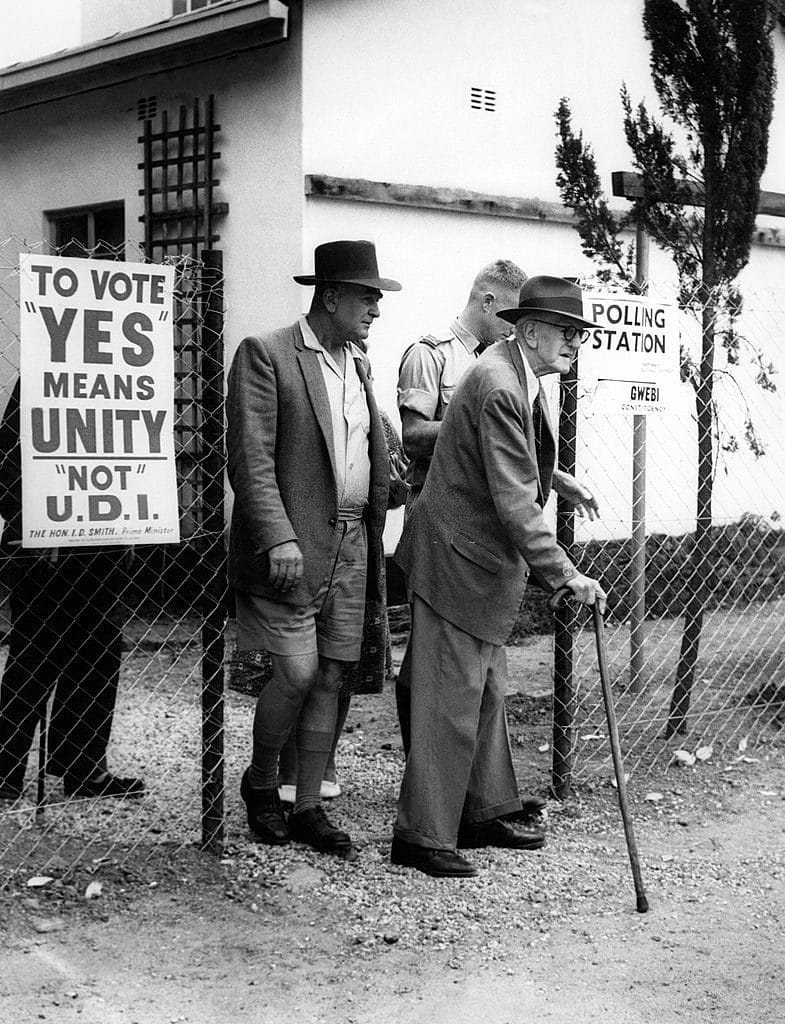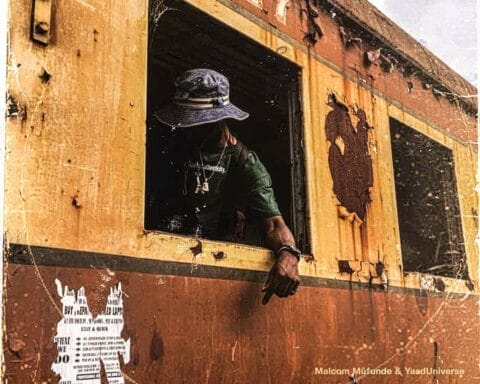In September 1890 Cecil Rhodes’ pioneer column trundled into Mashonaland to establish Fort Salisbury and the new colonial state named after its founder: Rhodesia. 90 years later white-ruled Rhodesia became the independent state of Zimbabwe. In the 1890s the first settlers brutally suppressed a series of ‘native rebellions’ or Chimurenga (the Shona word for ‘resistance’), as the indigenous peoples called their defence against alien invaders. Thereafter, white Rhodesians fought a number of wars on behalf of the British Empire and the Rhodesian Bush War, which lasted fourteen years and took over 30,000 lives.
The Rhodesian Bush War — also called the Chimurenga II and the Zimbabwe War of Liberation — was a civil conflict from July 1964 to December 1979. The conflict pitted three forces against one another: the Rhodesian white minority-led government of Ian Smith (later the Zimbabwe-Rhodesian government of Bishop Abel Muzorewa); the Zimbabwe African National Liberation Army (ZANLA), the military wing of Robert Mugabe’s Zimbabwe African National Union (ZANU); and the Zimbabwe People’s Revolutionary Army (ZIPRA) of Joshua Nkomo’s Zimbabwe African People’s Union (ZAPU).
Chimurenga II
Chimurenga II derived its inspiration from the first unified Shona and Ndebele war against British colonialism of 1896-1897, Chimurenga I. For over 70 years the Shona and Ndebele suffered landlessness, disenfranchisement, Britain’s apathy, various diplomatic failures to achieve universal suffrage, and the settlers’ Unilateral Declaration of Independence (UDI) in 1965, which was accompanied by the banning of black political parties. This state of affairs precipitated African nationalism and peasant radicalism by the mid-1960s. Chimurenga II was a war of liberation in which freedom fighters were to reclaim their land by resisting the UDI and colonialism while achieving democratic self-governance. The war was unevenly waged by the Zimbabwe African National Union (ZANU) and Zimbabwe African Peoples Union (ZAPU), through their military wings, the Zimbabwe National Liberation Army (ZANLA) and the Zimbabwe People’s Liberation Army (ZIPRA), respectively. The ZANU-ZANLA, representing 80 per cent of the population, dominated Chimurenga II, with the ZAPU-ZIPRA increasing its military activity in the mid-1970s. The political leadership mostly consisted of university graduates; commanders and cadres generally had high school educations or less. Banned in Rhodesia, nationalist politicians formed governments in exile in 1964, with the ZANU and ZAPU headquarters in Tanzania and Zambia, respectively, from which Chimurenga II was organized.
Initially, the ZANU proclaimed socialism and radical revolutionary strategies contrary to the ZAPU’s communism, but in the end they both advocated for scientific socialism. The ZANLA forces originally trained in China, Cuba, Ethiopia, Mozambique, North Korea, Tanzania, Romania, and Yugoslavia were persistently deficient in military resources as compared to the ZIPRA cadres, trained in Algeria, China, Czechoslovakia, Ghana, North Korea, and Russia.
Phase 1 (ca. 1966 to 1970)
The first phase of the Bush war, which lasted from 1966 to 1970, was a turning point of the liberation struggle and focused on disrupting law and order. In 1966, a fierce battle took place at Senoia in which ZANLA warriors, intending to sabotage the Kariba Dam’s hydroelectricity output, were inadvertently ambushed by Rhodesian forces, instigating conventional warfare with a more superior military force. The ZIPRA followed suit, simulating the Shona and Ndebele unity of Chimurenga I. While avoiding detection from police dogs, air searches and notorious government trackers (Selous Scouts) masquerading as guerillas, early freedom fighters faced thirst and hunger while carrying heavy weaponry loads across the treacherous and crocodile-infested Zambezi River, and the survival of the ruggedness of the Zambezi escarpment. The ZIPRA, commanding most guerrillas at the time, registered record setbacks due to the conventional warfare strategy of the Rhodesian forces, whose counterinsurgency entailed ruthless massacres of guerrillas, showcasing their mutilated corpses, and torturing survivors and peasants considered Chimurenga allies. Such was Rhodesia’s practice in the aftermath of the 1968 Hwange battle of 70 ZIPRA and African National Congress (ANC)-South Africa guerrillas in which there was one survivor. This alliance legitimized South Africa’s military intervention in Rhodesia throughout the war, taxing Chimurenga heavily. Costly experiences of the first phase taught the freedom fighters to win the hearts and minds of peasants while avoiding conventional warfare.
Phase 2 (ca. 1971 – 1973)
The second phase of Chimurenga II (1971-1973) prioritized clandestine countryside infiltration; raising peasant awareness; self-reliance in recruitment, training, and logistics; establishing the process of seizing power; constitutional development; and preparing for a protracted hit-and-run war to exhaust and liquidate the Rhodesian regime, ultimately liberating Zimbabwe. The effort of gaining mass support for the revolution was aided by traditional spirit mediums’ articulation of people’s concerns, promotion of principles of hunhu (virtue), and effective guerrilla warfare. The Rhodesian government became aware of the second phase of Chimurenga II after the ZANLA’s battalion of 60 had mounted a cutting-edge offensive in December 1972 and responded by installing barbed wire-protected villages, with nightly floodlights, in Mtoko, the base for the Rhodesian Security Forces and Joint Operations Command for Operation Hurricane in northeastern Mashonaland. The Shona, particularly Karanga staffing the majority of the government’s African troops also dominated the rank and file of the ZANLA.
At the end of this phase, the ZANLA had developed an elaborate system of partyorganization and liberation support structure, with committees and officers responsible for logistics, political commissar, record-keeping, food supplies, and finance. Parents’ committees (vabereki) worked with messengers of guerrillas (mujiba, male messengers) and (chimbwido, female messengers) numbering 50,000 by 1979 to provide a transportation and intelligence communication network. Camaraderie was monitored through pungwes (nightly political meetings) interjected with revolutionary songs.
Phase 3 (ca. 1974 – 1979)
The third phase of Chimurenga II (1974-1979) entailed a protracted intensification of military action, with Mozambique’s 1975 independence improving the ZANLA’s geopolitical situation and ability to expand the war, institutionalize ethos of purposeful transformation in its liberated zones, and access the midlands where the ZIPRA was already operating. An upsurge of peasants to front line states overwhelmed refugee camps, pressuring the ZANLA and the ZIPRA to shorten guerrilla-training periods. Rhodesia, having reinforcements from South African and U. S. troops and total control of the airfield, used fearsome force, claiming a “kill ratio” of 14 to 1 in the Operation Hurricane zone around Mutoko, with Selous Scouts murdering approximately 1,800 peasants by the end of 1979.
When the 1978 Zimbabwe-Rhodesia internal settlement excluded the ZANU-ZAPU alliance (Patriotic Front [PF]), the armed wings of which were attacking Rhodesia-South Africa forces, Chimurenga intensification forced all the parties concerned to include the PF at the Lancaster House independence talks. At the peak of the revolution (1978-1979), there were 22,000 guerrillas, with 13,000 operating within Rhodesia-Zimbabwe. Rhodesia-South Africa cross-border air bombings killed 1,000 refugees in Zambia alone and inflicted the highest refugee-camp deaths in front line states. Death rates of guerrillas, civilians, and security forces escalated at unprecedented proportions. In liberated zones, Chimurenga warriors blended with villagers in everyday activities while subversively planting explosives, slaughtering settler livestock, destroying government-operated veterinary services and schools, transmitting messages, and moving military reinforcements. These tactics were supported by the guerrillas’ ability to live in the forest, especially during the rainy season, when Chimurenga inflicted its most devastation while camouflaged by thriving bush cover. The ZANLA, responsible for 80 per cent of Zimbabwe’s guerrilla warfare between 1972 and 1979, dominated the armed struggle with impressive results.
Chimurenga’s successes were often disrupted by frequent leadership and tribal squabbles between Ndebele and Shona within the ZANU and the ZAPU, and the Front Line States’ push for detente with South Africa-Rhodesia, having a domino effect on ZANLA and ZIPRA forces. Despite the ZANLA’s triumph, an imposed 1976 joint ZANLA and ZIPRA military force, the Zimbabwe Peoples Army, led to a mutiny accentuated by the tendency of the front line states to overlook factionalism. Front line states also coerced liberation movements to form the Patriotic Front (PF), an alliance among the ZANU, the ZAPU, and the ANC, and engage in detente with Rhodesia-South Africa or face mass extradition.
When the PF was formed, many peasants were alienated by the ruthless fighting and recruitment strategies. A pattern of intimidation, coercion, kidnappings, selective assassinations, massacres, and armed confrontations emerged among both guerrilla and Rhodesian forces. These catastrophes drove entire communities off their lands, causing widespread homelessness and social disruption contrary to the original Chimurenga principles of hunhu proclaimed by spirit mediums. The war reduced Rhodesia’s economic viability by disrupting businesses, schools, and farming and inflating the defense budget when the tax base sustaining the expensive war had been shrunk through settler depopulation from 278,000 to 230,000.
In 1979—known as gukurahundi (the year of the peoples’ storm)— ZANLA had 20,000 fighters, and Rhodesian Marshall Law had been expanded to cover 95 per cent of the country. Between December 1972 and January 1977, 3,845 peasants, 760 security forces, 310 white civilians, and 6,000 freedom fighters were reported killed. In 1979 alone, death rates increased by 45 per cent among peasants, 60 per cent among civilian whites, 50 per cent among ZANLA forces, and 37 per cent among Rhodesian forces. By the time of the December 1979 cease-fire, there were approximately 40,000 dead consisting of 7,000 black civilians, 10,000 guerrillas, 700 black security forces and 350 whites (the rest murdered in exile). There were approximately 22,000 ZANLA and 8,000 ZIPRA forces operating in Zimbabwe-Rhodesia who were placed in assembly points under external pressure from front line states, the United Nations, Britain, and the United States, even before the Lancaster Agreement leading to the end of Chimurenga II and subsequent the ZAPU-ZANU (PF) independence victory of 1980 was achieved.








